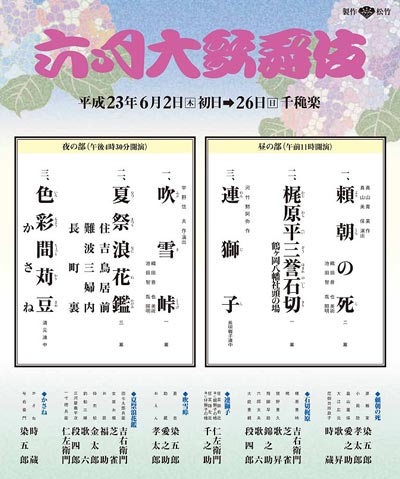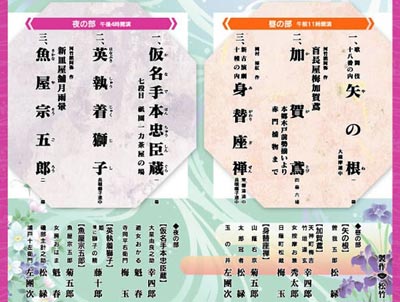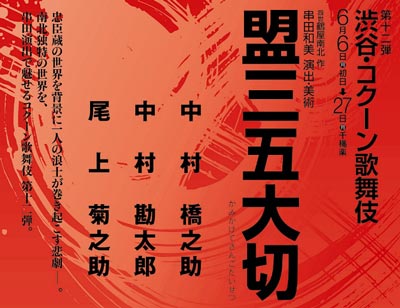| Comments |
Yoritomo no Shi: a play by Mayama Seika first presented in 1932.
Minamoto no Yoritomo created a strong warrior government, but died very soon,
leaving things to his son Yoriie (Ichikawa Somegor˘). But Yoriie feels that there is
something suspicious about his fatherĺs death and is in torment because even
though he is supposed to be the most powerful man in the land,
no one will tell him anything. It ends with a confrontation with his
mother H˘j˘ Masako (Nakamura Tokiz˘), who is ready to kill her own son rather than let the truth
out that could destroy their rule. She declares that a man has only one
short life, but the clan must survive to the end of time.
Featuring also Kataoka Takatar˘, Kataoka Ainosuke and Nakamura Kash˘.
Ishikiri Kajiwara: the Heike general Kajiwara (Nakamura Kichiemon) is asked to
test the sharpness of a sword by slicing two live human beings in half.
He deliberately makes the sword fail the test to keep the sword,
a priceless heirloom belonging to the enemy Genji clan, from falling into
the hands of his Taira clan. A miracle has convinced Kajiwara to change sides.
Kajiwara finally demonstrates the true power of the sword by cutting a
large stone basin in two.
Featuring also Nakamura Shibajaku, Ichikawa Danshir˘, Nakamura Kinnosuke, Nakamura Karoku and Nakamura Kash˘.
Renjishi: 2 entertainers dance a tale of the legendary shishi or lion-like spirits that live at the foot of a
holy Buddhist mountain. There is a comic interlude with 2 Buddhist pilgrims. Then, the shishi themselves appear and perform their dance with wild shaking of their long manes.
The dance shows a parent shishi forcing his cub to undergo harsh training in order to grow up strong.
This theme is often associated with the training a parent actor gives his son.
This performance features Kataoka Nizaemon in the role of the parent shishi and
his grandson Kataoka Sennosuke in the role of the cub.
Fubuki T˘ge: Oen and Sukez˘, an adulterous couple, have to take refuge
in a mountain hut built for pilgrims because of a violent snow storm.
Oen was the wife of the gambler Naokichi, who was Sukez˘'s boss. They fell in love
and, in order to escape death (a normal punishment for their immoral conduct),
they had to elope. They now live as fugitives, in great fear of revenge by Naokichi.
Fate has something in store for them as, this very night, Naokichi, who goes on
pilgrimage, has to shelter himself in the same hut...
Featuring Ichikawa Somegor˘, Kataoka Takatar˘ and Kataoka Ainosuke in the roles of Naokichi, Oen and Sukez˘.
Natsu Matsuri: this grisly murder story became a smashing hit
when it was first performed in 1745 because of the chivalrous spirit of the
many ďsaka characters appearing in this story, the contrast between a brutal murder
and the jovial mood of a summer festival, and the splashing of real water
used on the stage. Danshichi, a gallant fishmonger, does everything he can to protect
the weak young son of his patron with the help of his companion Tokubŕ
and the older Sabu. Although even Tokubŕ's wife Otatsu heroically helps out,
in the end, Danshichi is betrayed by his evil father-in-law Giheiji and,
in the most famous scene of the play, must kill him in a mud-covered fight
in a lonely alley with the shouts of the local festival nearby.
This program stars Nakamura Kichiemon as Danshichi,
with Kataoka Nizaemon, Nakamura Karoku and Nakamura Fukusuke as Issun Tokubŕ, Tsuribune Sabu and Otatsu.
Featuring also Nakamura Shibajaku, Ichikawa Danshir˘ and Matsumoto Kintar˘.
Kasane: one can never escape past evils. Yoemon is fleeing to the
countryside, but Kasane, the woman he abandoned, refuses to let him go.
She catches up with him at a lonely river bank. A skull stabbed with a
scythe appears and Kasane is possessed by its spirit, actually
the spirit of her dead father, and her face suddenly becomes disfigured.
She pours out her feelings of jealousy and resentment and Yoemon kills Kasane,
but even after her death, he cannot escape her vengeful spirit.
Starring Nakamura Tokiz˘ as Kasane and Ichikawa Somegor˘ as Yoemon.
Source: Earphone Guide website, except "Fubuki T˘ge"
|




